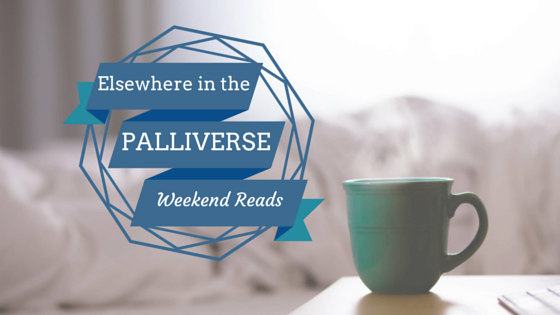Welcome to the 23rd edition of Elsewhere in the Palliverse. I hope you find value in this week’s links about palliative care and research – complete with animal story.
You’re welcome, animal-lovers.
As always, please share your thoughts in the comments.
Brand new blog DocGrief is “a dedicated space for health professionals to reflect and explore our relationship with death and grief, particularly when personally affected by a death in the family.” It was started by a rural GP based in South Australia. Her first post is heartfelt and I am following with interest.
Working in palliative care and geriatrics, I often think about carer stress in those caring for loved ones with life-limiting illnesses – it’s a relentless and sometimes thankless task. However, I have rarely thought of them having homicidal ideation. Dr Siobhan O’Dwyer recently published the paper Homicidal ideation in family carers of people with dementia, and I found the results confronting. Read more about it on her blog or at Australian Ageing Agenda. (If you’re contemplating suicide or homicide, please contact Lifeline on 131114 in Australia or 0800 543 354 in New Zealand or online.)
GP blogger Edwin Kruys asks Leanne Wells, new CEO of Australia’s Consumer Health Forum, “What health consumers want.” She also explains when to use the term “consumer” instead of “patient”. (What health consumers want: Interview with Leanne Wells, Doctors Bag)
In that vein, I’m glad I’ve never been asked to refer to a patient as a “client”. (Words Matter: Patients versus Clients, The Lancet Student)
Thanks to Change Day Australia for sharing this article from the Guardian UK, written by a hospital nurse – Compassionate care – a superpower or just part of the job?
EAPC Blog has a new series exploring end of life care for minority communities and how it can improved, starting with older LGBT people. (We treat everyone the same: Lesbian, gay, bisexual, and trans*people invisibility in end of life care)
“Dying at home is all the rage. Letting Granny wither away in a hospital or nursing home is so passé.” (Why dying at home is not all its cracked up to be, The Caregiver Space)
Two Graphs Show Just How Little Progress the U.S. has made on End-of-Life Care (NY Mag)
Caitlin Doughty’s latest “Ask a Mortician” video (below) takes a look at the interesting topic of mourning attire and how to wear your deceased loved one’s hair.
Why can’t we try this in Australia? What Happens When You Mix a Nursing Home with Childcare? (Thanks to my friend Sarah for sharing this with me, and to her patient’s friend for sending the link to her.)
Why academia needs emotional, passionate women (The Guardian)
When social scientists publish in medical and health care journals, in what order should the authors be listed? Is it better to be first or last? Or in the middle? What if you miss out altogether? This makes my head hurt. (First among equals? Recommendations and guidelines for deciding who gets authorship credit, Impact of Social Sciences Blog, London School of Economics)
Many clinician researchers probably fit into the category of “older, part-time and not working in an academic field”. This Thesis Whisperer post, Succeeding as a non-traditional student, is targeted at exactly that demographic.
This Celebrate Creative Ageing Sydney 2015 conference looks interesting. (25-27 August 2015 for those who are interested.)
Finally, here’s a palliative pet care story for those who enjoy them. (Georgia woman gives terminally ill shelter dog one “awesome final ride” with hospice bucket list, NY Daily News)

